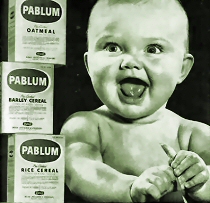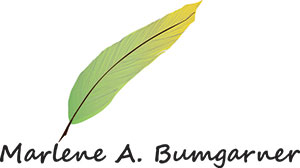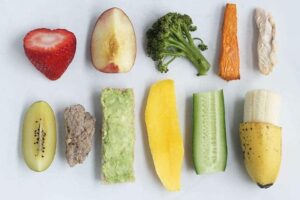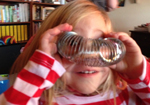No Pablum for This Generation
In the 1960s and 70s, when Baby Boomer parents were faced with the question “When should I start solids?” the answer was often “as early as possible.” At least that’s the answer our mothers and aunties and grandmothers gave us. “It’s the only way they’ll sleep through the night,” they said.
Even today, when I was at the public library researching this article, a very enthusiastic librarian explained the importance of adding “just a tiny bit of rice cereal and peaches” into a bottle of breast milk in order to convince a one or two-month old to sleep longer. “My daughter didn’t believe me, but she paid for it,” she concluded, waggling her finger. “My granddaughter didn’t sleep through the night until she was four months old. You tell people, just a tiny bit of cereal and sweet fruit – it works wonders.”
By comparison, parents today are being guided by the World Health Organization and their family doctor to delay feeding solid food until their babies are sitting up and are able to put the food in their own mouths. And looking to development to explain why some babies sleep through the night sooner than others, not pablum.
Feeding finger food at six months isn’t new. What’s new is that pediatricians no longer believe that children need to be spoon fed first. Stan Cohen, M.D., the author of What to Feed Your Baby: Cost-Conscious Nutrition for Your Infant gives a short history of infant feeding that helped me to understand how we got here:
Here, Dear. Have a Carrot.
The reason this topic is of particular interest to me at this particular time is that both of my youngest grandchildren, ages 5 months and 6 months, were introduced to people food last week. Pictures of each girl, sitting proudly in her new high chair, chewing on cooked carrot spears, pieces of peach and banana and broccoli florets came repeatedly to my iPhone screen throughout the week, and made me smile.
 However, I wasn’t completely free from anxiety. These babies had never eaten from a spoon. They had never “practiced” eating with rice cereal (ok, it could be brown rice, I’ll concede that), or applesauce or strained peas. My own children didn’t eat the packaged infant foods so popular at the time, but I did put their earliest solids through a baby food grinder at the table, then coaxed the mush into their mouths, struggling with a thrusting tongue that didn’t want to cooperate. Weren’t these babies at a higher risk for choking, having skipped that process?
However, I wasn’t completely free from anxiety. These babies had never eaten from a spoon. They had never “practiced” eating with rice cereal (ok, it could be brown rice, I’ll concede that), or applesauce or strained peas. My own children didn’t eat the packaged infant foods so popular at the time, but I did put their earliest solids through a baby food grinder at the table, then coaxed the mush into their mouths, struggling with a thrusting tongue that didn’t want to cooperate. Weren’t these babies at a higher risk for choking, having skipped that process?
Well, actually, no. It turns out that being fed soft food from a spoon isn’t necessary in order for children to learn how to masticate fruits, vegetables, or meat. That takes a different skill set. Many of today’s new parents skip that stage entirely, and the babies learn to eat soft chunky foods just fine.
Dr. Cohen explains that too:
Baby-Led Weaning Doesn’t Mean You Have to Wean
The leaders of the march to skipping the mush and the spoon feeding and going directly to offering people food seem to be Gill Rapley and Tracey Murkett, the authors of the 2005 book Baby-Led Weaning in which the principles, research, and steps of the process are presented in easy-to-understand language. Including a translation for US readers of the UK use of the term “weaning.”
Adding interesting new food to the diet meets the growing nutritional needs of the child, but it does not necessarily signal the end of breastfeeding or bottle feeding of formula. That decision can and probably should be made separately, based on a variety of factors.
Here, for those of you who may also be new to this idea, and before any of us put our feet into our mouths and upset our sons and daughters, are some of the basic principles of BLW, from The Baby-Led Weaning Cookbook:
- The baby is included in family mealtimes, where she watches what others are doing and is offered the chance to join in.
- Nobody “feeds” the baby; when she is ready she starts handling food and taking it to her mouth herself (at first with her fingers and later with silverware).
- To start with, food is offered in pieces that are easy to pick up.
- It’s up to the baby how much she eats and how fast she eats it.
- The baby continues to have milk feedings whenever she wants them, and she decides when she is ready to begin reducing them.
I was half way through writing this article yesterday, when I went to a rather posh fundraising dinner, complete with white tablecloths, stemware, and more than one fork. Directly across from me was a young couple and their son, possibly six or eight months of age. During the meal I received a wonderful lesson in BLW, as the parents, eating their own meals and conversing with those around them, deftly kept a supply of small bits of food on their plates in front of the boy. He was an active child, and did his share of wiggling and climbing from mom to dad and back again, but he was quiet and happy while he was eating, and quite satisfied with the food that was being offered.
Baby-led weaning often leads to more relaxed mealtimes for the whole family, and it’s definitely easier on the parents. I wonder why it took us so many years to figure this out?
Share this post





Hi Marlene,
I am the grandmother of that active baby boy you met at the posh dinner a few weeks ago. They told me about you and gave me your card so I could read your blog. I am so happy to read your blog because as the granny/nanny I sometimes feel quite challenged to keep up with all the new ways of parenting.
Thank you,
Granny Kate
Kate,
What fun! I am so happy to hear from you and to learn that my post was useful to you. Welcome!